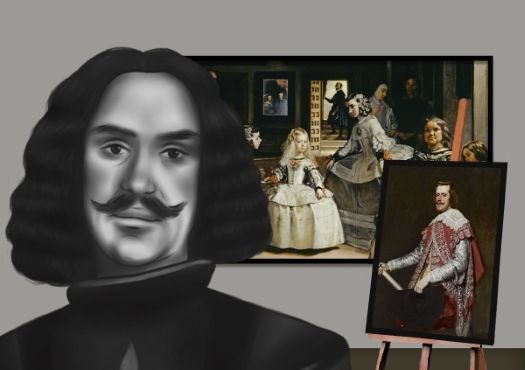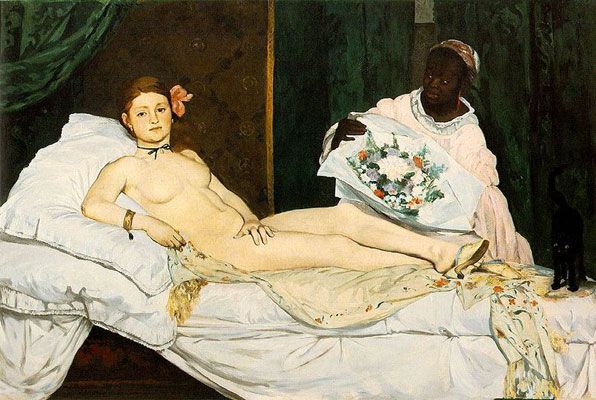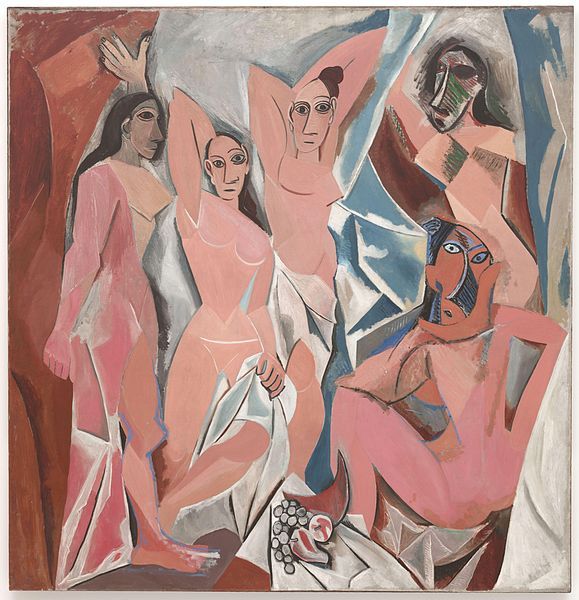Summary of Diego Velázquez
Although Diego Velázquez's primary position was one of prestigious court painter for Spain's King Philip IV during the Baroque period, he is most celebrated for breaking portraiture and scene painting out of its staid confines. His individualistic style of naturalism, a precursor to realism, favored authenticity over the romantic and differentiated him from others of his time who stayed bound to the traditional and historical ways of depicting their subjects. Vastly personable, and as equally interested in the common man as the lauded man, he managed to create a fiercely individualistic and impressive body of work that belied his underlying passion for the human being and human experience. He remains one of the most important artists of the Spanish Golden Age.
Accomplishments
- Although he was paid to create work for royalty, Velazquez maintained an extreme commitment to also depict everyday people and scenes. He managed to quell the external influences of popular opinion, which deemed this work wasteful or meaningless, by creating pieces so compelling they could not escape interest.
- Velazquez's intensely direct style of painting truth was photorealistic in nature and far ahead of its time. He infused various techniques toward accurately depicting detail and its many nuances including free, loose brushstrokes, the utilization of gradients of light, color, and form, and an eye for detail that was unsurpassed by his peers. This style would become an early forebear to both Realism and Impressionism.
- Velazquez was a master of the use of chiaroscuro, or, the treatment of light and shadow in a painting to create high contrast. He utilized this technique to highlight points of particular importance to the viewer and to set an overall atmospheric perspective.
- Composition was a strategic tool for Velazquez in motivating the viewer to experience his work as it was intended. To this end, he often used diagonal structures, complex focal points, and separate planes to manipulate the eye toward what was most important, or to spur a deeper understanding of the picture.
- Velazquez's masterpiece Las Meninas (The Ladies in Waiting), has become one of the most analyzed works in Western painting. By placing a rendition of himself as artist into an intensely private scene with his royal subjects, he remarked not only upon the position of the painter as one who is allowed to glimpse moments of intimacy that viewers would not ordinarily be privy to, but to then authentically portray them armed with the artist's signature tools and techniques of the trade. It is a great testament to the role of the painter.
Important Art by Diego Velázquez
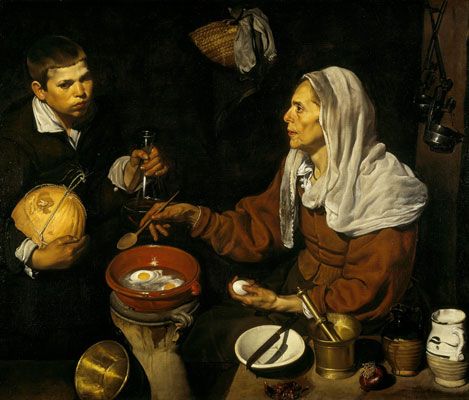
Vieja friendo huevos (Old Woman Frying Eggs)
At eighteen years of age, Velazquez painted this picture in the style of a Spanish bodegone, or small genre scene that depicts normal, everyday people in a common situation, many times involving food and mealtime gatherings. It is known for its unflinching naturalism. In it, Velazquez took care to lovingly render the many subtle changes of the tones in skin, the graceful folds of soft fabric in the old woman's scarf, the gleam and delicate shadows of metal in the pots, and the rich sheen of the red onion's skin. The center of the composition is the food, the pot of cooking eggs, and the hand of the woman above it. The bright melon and the boy's solemn face, his left hand, and the woman's hands pull the viewer's eyes in and around the scene. It a great example of Velazquez's commitment to not only showing us the privileged lives of his royal subjects, but also to express his love of everyday people and experiences with a noted sincerity toward depicting reality in all its forms.
Although the subject matter is decidedly more humble than his portraits of kings and their accompanying entourages and historical situations, Velazquez treats the subjects of this painting with the same masterful touches signature to his artistic voice. There is a strong use of chiaroscuro, in which the dark, disappearing background juxtaposed with lighter, high contrast areas and objects tell the story. This is shown to us in high contrast with unsurpassed realism. The ovular construction of the composition is designed in such a way that it opens up to include the viewer using Velazquez's common strategy of diagonal planes and coextensive spacing. A combination of loose and fine brushwork is utilized to create surface tension and emphasis on various objects and the faces. The background is immersed in darkness, creating a theatrical effect that renders his subjects, even in their mundaneness, as grand central figures as if spot lit upon a stage.
In 1889, biographer Karl Justi quoted Sir J.C. Robinson's observation that "...The pictures of Velazquez have this in common with photographs, that they impress the mind with such a powerful sense of actuality..."
Oil on canvas - National Gallery of Scotland, Edinburgh
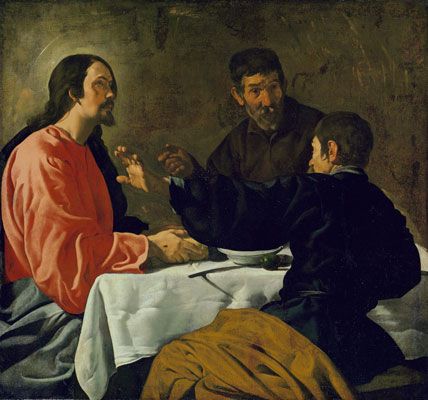
The Supper at Emmaus
Here the precise realism and actions of the figures portrayed with strong dramatic lighting recall the work of Caravaggio, which Velazquez may have studied from copies in Seville. Christ is depicted at the moment of recognition by two disciples after his resurrection.
Velazquez's experimentation with different perspectives and his ability to draw the viewer into the drama of the artwork were unparalleled by his contemporaries. The light source in this work enters from our left and appears centered on or near Christ's head. This creates illuminated faces and a darkened background. The primary focus is on Christ; he emanates a quiet, pensive presence while the disciples react with movements and expressions of surprise or emotional confusion.
The many diagonals pull us into and around the composition. The dark figure with an outstretched arm and his back to the viewer in the foreground leans in and over the table. The man across from him leans toward Christ, and gestures in his direction even as he addresses his fellow disciple. All hands visible are near Christ, who gazes up, out of the immediate space. His light colored, garmented arm and hand form a curve leading into the center of the scene. The table with a white cover stabilizes the middle ground to help us understand the dramatic, active arrangement. Velázquez emphasizes the individuals but uses color, light, and motion to involve the viewer. Karl Justi, the author of Diego Velázquez and His Times, noted that Antonio Ponz, the cicerone or learned guide for viewing Spanish art, advised that "...the best models of the natural style are the works of Diego Velázquez, in their knowledge of light and shade, in the play of aerial effect, which are the most important features of this style, because they give a reflection of the truth."
Oil on canvas - The Metropolitan Museum, New York City, New York
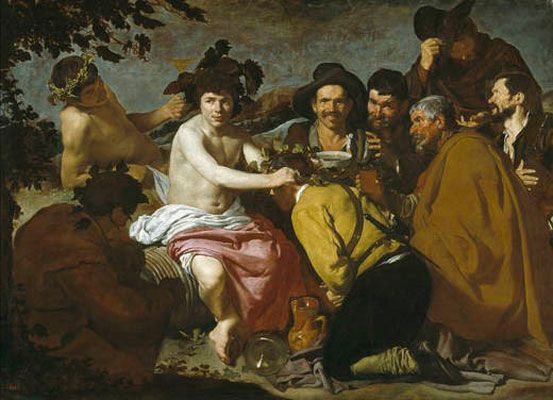
The Triumph of Bacchus
Velázquez's masterpiece of the late 1620s might be interpreted as a response to the criticism of his rivals of the Spanish court; it had been said that he was a mere portraitist and not able to compete in the lofty sphere of history painting. An alternate Spanish title for the painting is Los Borrachos or "The Drunks" and it was painted for Philip IV who hung it in his summer bedroom.
The scene is a depiction of Bacchus, or Dionysis, the god who rewards men with wine, temporarily releasing them from their problems. In Baroque literature, Bacchus was considered an allegory of the liberation of man from the slavery of daily life. In the painting, the god is surrounded by eight drinkers, which was a rare subject in Spanish painting. Drunkenness was condemned in Spain but the royal court found it entertaining to bring in low-life people from comedy theaters and inebriate them for the amusement of the ladies.
The painting is firm and solid in its figures while the light and dark areas show an evolution from Velazquez's former works. The composition was devised using many diagonals and complex focal points to involve the viewer. On the left, Bacchus and the satyr behind him are quite naked except for the traditional loose cloths of classical mythology. Bacchus is posed and vividly illuminated; he looks out of the painting as he places a leafy wreath on a man in a golden jacket kneeling before him. An extremely dark mythological figure crouches in the lower left. The right side of the composition is made up of several darkly clothed older men who are drinking and conversing. Two of the men look directly out at the viewer as if to invite them in to the merriment.
The piece is noted for its use of Velazquez's signature naturalism, that even when transposed upon a subject of mythical proportions manages to maintain a sense of realism - practically welcoming the spectator to partake in the dreamy scene.
Oil on canvas - Museo del Prado, Madrid
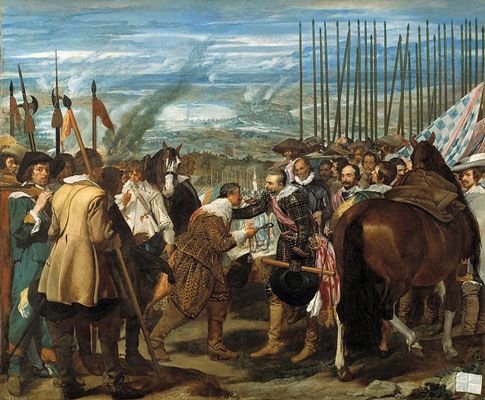
The Surrender of Breda
When he returned to Madrid from Italy, Velázquez continued his employment with the Spanish Court. By 1634, he was working on the decorations for the Buen Retiro palace. The Surrender of Breda was one of these works; it was planned for display in the throne room of Philip IV. The large painting, around ten by twelve feet, was part of a cycle of work composed of twelve battle scenes, each one painted by a different artist.
The fortress of Breda was significant in Spanish history because it was the location of a victory led by Ambrogio Spinola, a famous Spanish general, after a siege of the fortified Dutch city of Breda which lasted for twelve months. Velazquez painted the scene of the ceremonious handing over of the keys to the fortress. Defeated Dutch soldiers stand at the left, weary orange flags atop their lances, while the victorious Spanish forces are on the right. A bird's eye view of the town appears in the background, possibly recreated by Velázquez from maps or engravings of the region. This painting is also popularly called The Lances due to the forest of raised lances in the top right corner. They are held aloft by the victorious Spanish troops in a striking display of power and discipline.
The painting features the opposing commanders in the center of the composition. Justin of Nassau is shown handing over the key to the city to the Spanish general, Spinola. Justin, whom Velázquez never met, is turned away from the viewer and his face is dark; Spinola, whom the artist knew from Philip's court, looks out toward the viewer and his face is highlighted. The Spaniards were proud of Spinola's graciousness, depicted through not only his facial expression but also his outstretched hand on Justin's shoulder. Although the incident never occurred as it is pictured here, it nonetheless lived in the popular imagination, and Velázquez may have seen the scene similarly staged in a contemporary play by Calendron. In the midst of an unpopular war to subdue the Netherlands, The Surrender of Breda captures a moment of Spanish mercy and strength. As Laura Cumming wrote in The Vanishing Velazquez, "Velazquez began the picture six years after meeting Spinola, yet the portrait is quick with character and life. No human encounter is lost, with Velazquez, no conversation wasted."
The Surrender of Breda is a complicated composition due to the large number of figures, the animals, the complex crowds, and many battle accessories. In order to organize and balance the painting, Velázquez employs a device he commonly used throughout his career: he divides the action into two spaces. The reality of the war and siege is compressed into the background, to remind the viewer of the history surrounding the main event in the foreground. The palette of colors is surprisingly light and bright for Velázquez compared to most of his work. Even pastel colors are used, in the uniforms of the soldiers in the background and the sweeping flags to the right of the canvas.
The painting is also a fine example of the free, loose brushstrokes that characterize Velázquez's style and had an impact on the art of Manet and the Impressionists. Here Velázquez varies his brushstrokes; in the foreground, they are tighter and more controlled, but grow increasingly loose and abstract receding into the background, helping the artist to create a sense of atmospheric perspective.
Oil on canvas - Museo del Prado, Madrid
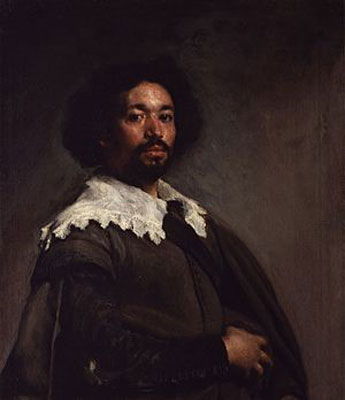
Portrait of Juan de Pareja
In 1648, Philip IV sent Velázquez to Rome to purchase works of art for the Alcázar Palace in Madrid. Velázquez brought with him Juan de Pareja, who served as his manservant. About forty years of age in this painting, Pareja was a Sevillian of Moorish descent and a slave, whom Velázquez had inherited from a relative. He had been working in Velazquez's studio since the 1630s and soon after this portrait was made, Pareja was given his freedom. The two men landed in Genoa, traveled to Milan to see Leonardo da Vinci's Last Supper and then to Venice to see Tintoretto and Titian. They bought paintings of Titan, Tintoretto, and Veronese along the way.
During his stay in Rome, Velázquez painted this small oil portrait, less than two by three feet, of Pareja, perhaps in preparation for painting a portrait of Pope Innocent X. The portrait was displayed in Rome as part of a larger exhibition at the Pantheon in March 1650. According to Antonio Palomino's biography of Velázquez, the painting "...was generally applauded by all the painters from different countries, who said that the other pictures in the show were art but this one alone was 'truth'." Karl Justi affirms this opinion and added, "...in recognition of this, Velazquez became a roman Academician in the same year, 1650." Pareja was a gifted painter himself; he is included in Palomino's Lives and Works of the Most Imminent Spanish Artists, as is Velazquez.
Velázquez's portrait of Pareja shows strength, poise, and pride. Pareja is posed in a three-quarter view gazing directly and intently at the viewer. Velázquez adds to this commanding presence with the skillful use of color. The overall gray tones of the clothing in the painting contrast with the warmer tones of Pareja's face and the ear is just a dab of red paint. The face is strong, determined, and expressive; the portrait conveys an overwhelming sense of human dignity. The collar is a dazzling rich, creamy arrangement of quick lead white brushstrokes over Venetian grey. It was banned as too sumptuous under Spanish laws for a lower class wearer but here it is a symbol of freedom. Velázquez treated Pareja with the same solemnity and respect seen in his royal portraits, but with a more personal touch. It remains a great testament to Velazquez's love of portraying even the common man, so great was his commitment to express the authentic alongside the grand.
Oil on canvas - The Metropolitan Museum, New York City, New York
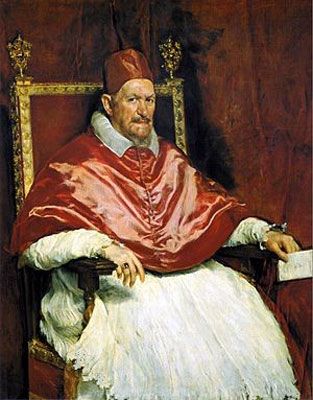
Portrait of Innocent X
Velazquez not only supplied the Spanish court with portraits in Madrid; he became the portraitist for the papal court in Rome. Created during his second trip to Italy, this style was called the manera abreviada because it was a bolder, sharper style of painting.
Velazquez had studied earlier portraits of popes by Raphael and Titian but he painted a powerful depiction of Pope Innocent X exactly as he saw him: a wary, suspicious old man on guard. The Pope was not an attractive man nor was he ever described as likeable. Velazquez's masterful portrayal of the many fabrics: silk, linen, velvet, and gold, and his use of light with different tones of red and white bring an atmosphere of strength and power to the image. His loose, almost imperceptible brushstrokes allow him to present the many textures and surfaces of the scene as well as infuse vitality and energy. The portrait shows Pope Innocent X with such a severe, bitter expression that people in the Vatican were concerned that the Pope would be displeased. Initially, Pope Innocent X thought the portrait was too realistic and he declared "troppo vero" or too true, but he eventually approved and became a supporter of Velazquez. He in fact grew so impressed and satisfied with the painting; he had it hung in his official visitor's waiting room.
Velázquez took a copy of the portrait, which the English portrait painter Sir Joshua Reynolds considered the finest portrait in Rome, back to Spain. As the biographer Karl Justi described in Diego Velázquez and His Times, "...the work met with great approbation amongst art circles in Rome." The biographer Palomino further commented, "...Our Velazquez came to Italy not however to learn but to teach; for the portrait of Pope Innocent X was the amazement of Rome; all copied it as a study and looked on it as a marvel."
British Expressionist artist Francis Bacon considered Portrait of Pope Innocent X to be one of the most successful portraits ever painted, because Velazquez had transformed what would ordinarily be a flattering portrait of homage to a highly lauded religious figure into a unflinchingly intuitive glance at the real man simmering beneath the esteemed robes. Bacon's own work would often take the shape of tortuously indicative portraits about the inner nature of man.
Oil on canvas - Galleria Doria Pamphilj, Rome
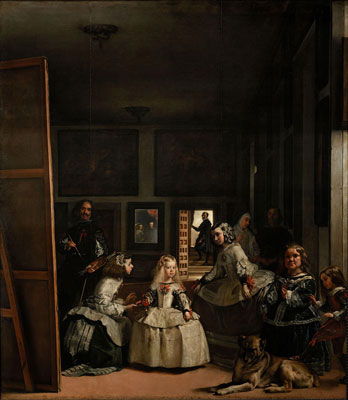
Las Meninas
Las Meninas, or the Maids of Honor, is considered to be one of Velazquez's most famous masterpieces, representing the sum total of a career's worth of genius, intelligence, and technical mastery. It is also lauded, even 300 years later, by artists and viewers alike as a seminal example of the art of painting. The complex and mysterious piece intrigued all who looked at it and it has been called a resume of Velazquez's entire life and career.
Visually, it is a sumptuously depicted scene in which the five-year-old Infanta Margarita, the heir to the Spanish throne, is surrounded by her ladies in waiting and other attendants. She is the daughter of King Philip IV and his second wife, Mariana of Austria. The painting itself is large, around seven by ten feet, and Velazquez is seen standing behind a large canvas on the left side of in his spacious studio in the Royal Alcazar in Madrid. The strongly foreshortened wall on the right has three rows of artwork, which help to establish the space. More than half of the space is dim, dark, and empty around the figures. The royal couple is shown as a reflection in a mirror on the back wall. Two Court dwarves, and a large dog linger in the bottom right hand corner. Behind the dwarves, two women, a nun, and a lady's guard are in conversation while the queen's quartermaster is seen on the stairs at the rear in front of an open sunlit door. The story has been related that the royal parents were weary of posing for Velazquez and sent for the princess to amuse them. King Philip IV was an amateur artist and a good friend of Velazquez and he recognized this busy gathering as a special moment. This resulted in a rare, intimate depiction of the Spanish royal family, their attendants, and a self-portrait of the artist. The relentless Court etiquette is less evident in this private scene. In her Memoirs, Madame de Motteville, who was present at the scene, writes of the young princess, "She is waited on with great respect, few have access to her and it was a special favor that we were allowed to linger at the door of her chamber."
Technically, the work is a testament to Velazquez's brilliance with composition. He was very masterful in his use of one-point perspective and chiaroscuro to control the space of the high-ceilinged room in this painting. He utilized strategic placement of his subjects to create multiple visual planes and diagonals, which draw the eye to various areas of the room in a balanced fashion. We are led not only to witness the activity in the room, but also to ponder what is outside the frames of what we can see. This is accomplished through the eyes of the princess and others as they peer out toward the viewer as if about to be captured in a photograph; through the acknowledgement of the queen and king seen only in reflection, and in the open door at the back of the room that displays the light of the world outside. The painting is considered a perfect construction, so much that other painters continue to study it, emulate it, and draw inspiration from its ideal form.
The importance of Velazquez's art is very evident in the great respect given to him by his contemporaries and more modern painters. Picasso painted many versions of Las Meninas in his own avant-garde Cubist style but maintained Velazquez's general form, naturalness, and positioning of the figures. Salvador Dalí created Velazquez Painting the Infanta Margarita with the Lights and Shadows of His Own Glory using Velazquez's color scheme as a tribute to the older artist but also to present his own newer theories of art and thinking. John Singer Sargent painted a smaller scale copy of Las Meninas in 1879 and later used a similar composition in his The Daughters of Edward Darly Boit.
Las Meninas is also seen to be autobiographical, a statement by Velazquez in his mature years, cementing himself in the annals of great artists, taking his place alongside his great idol Rubens, whose work is hinted at on the high walls in the back of the studio. This work is a visual argument to the virtue of painting, the role of an artist in finding the jewels of an intimate moment and expressing them visually for the world to enjoy.
Oil on canvas - Museo del Prado, Madrid
Biography of Diego Velázquez
Childhood and Education
Diego Rodriguez de Silva y Velazquez was the first of six children born to Juan Rodriguez and Jeronima Velazquez in Seville, Spain. He received fine training in religion, languages, and philosophy from his parents. His father recognized his son's early talent in drawing when his copybooks always turned into sketchbooks and arranged an apprenticeship for Velazquez to study with Francisco de Herrera the Elder. The master painter was considered to be the creator of the Spaniards' national style.
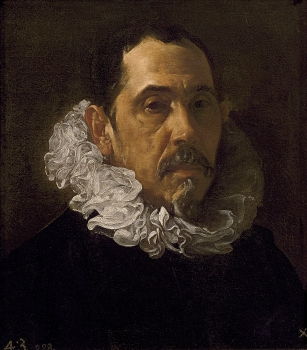
When Velazquez was 12 years old, he studied under the accomplished Spanish painter, Francisco Pacheco, who taught him technical drawing and painting as well as literature and philosophy. The biographer Karl Justi described Pacheco as not only a painter but also a poet, biographer, and art theorist whose "...studio was a formal academy of the most cultured Sevillians and strangers..." Pacheco also had influential contacts in the Spanish royal court, which was of great value to his students, many of whom had ambitions to garner esteemed positions as court artists.
At the time, the talent of painters was most often employed to depict scenes from great religious and historical narratives, or to create portraits for royal and wealthy patrons. But even as a young painter Velazquez was drawn to paint all types of people and situations. He was sometimes criticized for his works that showed common people engaged in domestic tasks. However, Pacheco, in his 1649 treatise Arte de la pintura ("The Art of Painting"), recalls Velazquez as saying, "...I would rather be first painter of coarse things than second in higher art..." Pacheco was ultimately impressed by Velazquez's virtue, integrity, disposition, and talent, and admired that, "...he worked from life, making numerous studies of his models in various poses and thereby gained certainty in his portraiture."
Early Period
After being accepted into the Painter's Guild of St. Luke in 1617, at the age of 18, Velazquez set up his own studio and married Pacheco's daughter, Juana. By the early 1620s, Velazquez had established his position and reputation in Seville. He started a family and continued to paint historical scenes, portraits, mythological, and sacred subjects.
In December 1622, the favorite court painter of young King Philip IV died and the King's minister, Count-Duke of Olivares, summoned Velazquez for the vacant position. Within two years, Velazquez was paid to move his family to Madrid, which became his home for the rest of his life. He was admitted to the royal service with a monthly salary, medical benefits, lodging, and payment for all assigned paintings; his life and career were well supported.
Velazquez's place of work was also a regular meeting place for many of Seville's leading intellectuals, artists, poets, and scholars. Frequently the discussion centered on master artists such as Michelangelo, Raphael, Titian, and Caravaggio and the theory of art. Velazquez was a popular figure in this thriving creative hub, as Laura Cumming explains in The Vanishing Velazquez - A 19th Century Bookseller's Obsession With A Lost Masterpiece. She writes, "Velazquez made connections everywhere he went with fellow painters, and he never forgot a friend; the visual proof appears in the course of a lifetime's portraits."
Although Velazquez was deeply embedded in Baroque tradition, his work exhibited points of departure that would eventually come to differentiate him from the other court painters of the time and deposit him into the realm of fiercely individualistic artists. Instead of the typical glamorization of his subjects, he painted with an interest in naturalism - a direct and precise realism that two hundred years later, after the advent of photography, might have been deemed photorealistic. He developed his own nature and principles of art to show people and situations as they authentically were, but also used compositional techniques that drew the eye toward parts of the work that he wished to emphasize. He would alternate the use of freestyle brushstrokes between loose or tight to conjure atmosphere. He had a flair for using qualities of oil point, the effects of light and dark, and color to maximize the way a human eye created a visible world and would experience a canvas. He seldom used lines in his finished work, his forms became defined by patches of hue, and the contrasts between highlight and shadow.
Mature Period
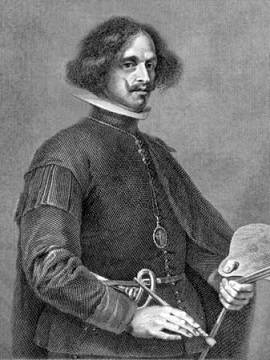
In 1627, King Philip announced a competition for the most accomplished Spanish painters. The subject of the paintings was deemed the historical expulsion of the Moors. Velázquez won but his painting was destroyed in 1734 by a palace fire. However, recorded descriptions of it explain a scene of Philip III pointing his baton at a crowd of people being led away by soldiers, while Hispania, the female personification of Spain, sits in calm repose. Velázquez was appointed gentleman usher as his reward, and received a daily allowance and an additional payment each year for dress.
In 1628 he received a visit from the older, renowned Flemish Baroque artist, Rubens, who spent six months at the court in Madrid. Velázquez and Rubens talked and worked together during this time and developed a deep mutual respect for each other. Rubens urged Velazquez to visit Italy where he believed real art began.
Velázquez made his first visit to Italy in 1629 with the permission of King Philip IV. He went to Genoa and Venice where he saw the work of Titian, whom he had admired since the days of his apprenticeship in Seville and whose influence upon his work was of dominance. He also visited Florence and Rome where the works of many masters were available for him to study. He stayed in Rome for almost a year, where he copied the master paintings and worked on his own canvases.
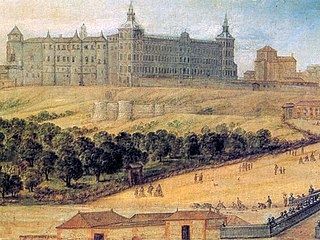
Back in Madrid, Velázquez continued in the employment of the Spanish Court. By 1634, he was working on decorating the Buen Retiro palace. Velazquez painted the scene of the ceremonious handing over of the keys to the fortress of Breda. That painting has been described as a superlative historical piece of work, perhaps the best in Western Europe.
Late Period and Death
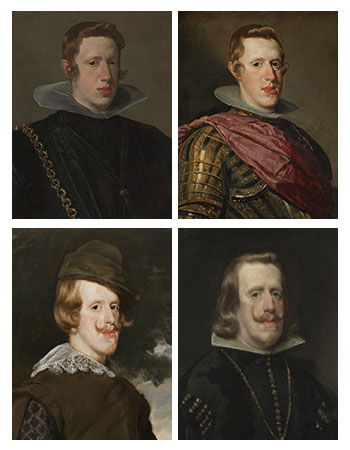
In 1649, Velázquez made a return visit to Rome where he painted his famous portrait of "Pope Innocent X" as well as a variety of other paintings. King Philip IV required Velázquez to return to Spain and accordingly, he did by way of Barcelona in 1651, taking with him many paintings and pieces of statuary. As Laura Cumming describes, "...the ten or so Roman portraits must show the influence of Italian painting, the fluent manner of Bernini, and of Titian before him...Rome was his freedom..."
Upon returning to Madrid, King Philip IV made Velazquez Supreme Court Marshal, an appointment that enabled him to expand his art workshop. He also took on many assistants and pupils, who unfortunately were not of the same artistic caliber. King Philip had married Mariana of Austria after the death of his first wife, whom Velázquez now painted in many variations. Yet far from indicating any decline due to these tasks, his works of this period are amongst the highest examples of his style.
Velazquez's last major work was a group portrait of the Spanish Royal Family titled Las Meninas (1656). Velázquez died in Madrid, in the palace where he spent so much of his time, in August 1660.
The Legacy of Diego Velázquez
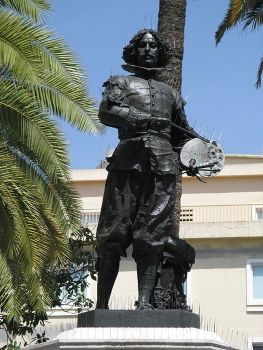
Until the 19th century, Velazquez's work was little known outside of Spain. In 1828, the Scottish artist, Sir David Wilkie, wrote from Madrid that he felt Velazquez was a new presence and power in art. He also sensed a relationship between Velazquez and the British school of portrait painters, especially Sir Henry Raeburn. He appreciated the modern impressions throughout Velázquez's work in both portraiture and landscape.
Velázquez is often named a key influence on the art of Édouard Manet and the Impressionists. Calling Velázquez the "painter of painters," Manet admired the bold combination of the free and loose brushstrokes that characterized his style even as he held true to his training in the Baroque academia of his contemporaries. Manet built upon Velázquez's motifs in his own art.
As a teenage art student at Madrid's Royal Academy of Fine Arts in 1897 and 1898, Picasso spent time in the galleries of the Prado, where he copied the works of Velazquez. Las Meninas was so influential that it led Picasso to recreate it 58 times in his late Cubist style in the 1950s.
The Surrealist painter Dalí was also inspired to develop his famous moustache after admiring that of Velazquez. He also reinterpreted Velazquez's painting in his 1960 work Portrait of Juan de Pareja, the Assistant to Velázquez. That same portrait inspired the 1965 novel I, Juan de Pareja by Elizabeth Borton de Treviño, which in 1966 was awarded The Newberry Medal, a children's literary prize.
Many other 19th and 20th Century painters were influenced by Velazquez's work including James McNeill Whistler, Thomas Eakins, Mary Cassatt, John Singer Sargent, Salvador Dalí, and Francis Bacon.
In the end, Velazquez's greatest contribution to art was in his ability to respectfully toe the line between tradition and modernity in a way that sparked both lovers of art and other artists simultaneously. Bacon has described Velazquez's genius as such: "One wants to do this thing of just walking along the edge of the precipice, and in Velazquez it's very, very extraordinary that he has been able to keep it so near to what we call illustration and at the same time so deeply unlock the greatest and deepest things that man can feel."
In today's contemporary art spheres we continue to find Velazquez's lasting impressions. In 1985-86, French-Senegalese artist Iba N'Diaye restaged one of his portraits for the painting Juan de Pareja agresse par les chiens (Juan de Pareja menaced by dogs). The same painting inspired the central theme of the 2012 play Disgraced by Ayad Akhtar, in which a South Asian Muslim man is painted by his white wife in its style.
Influences and Connections

 Ask The Art Story AI
Ask The Art Story AI